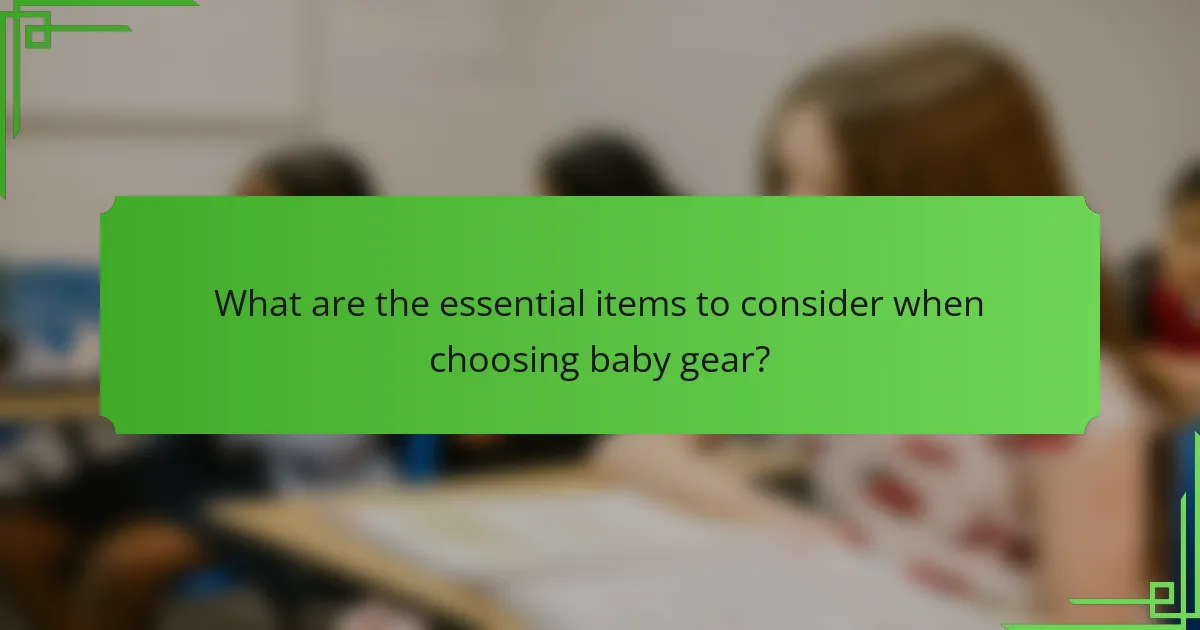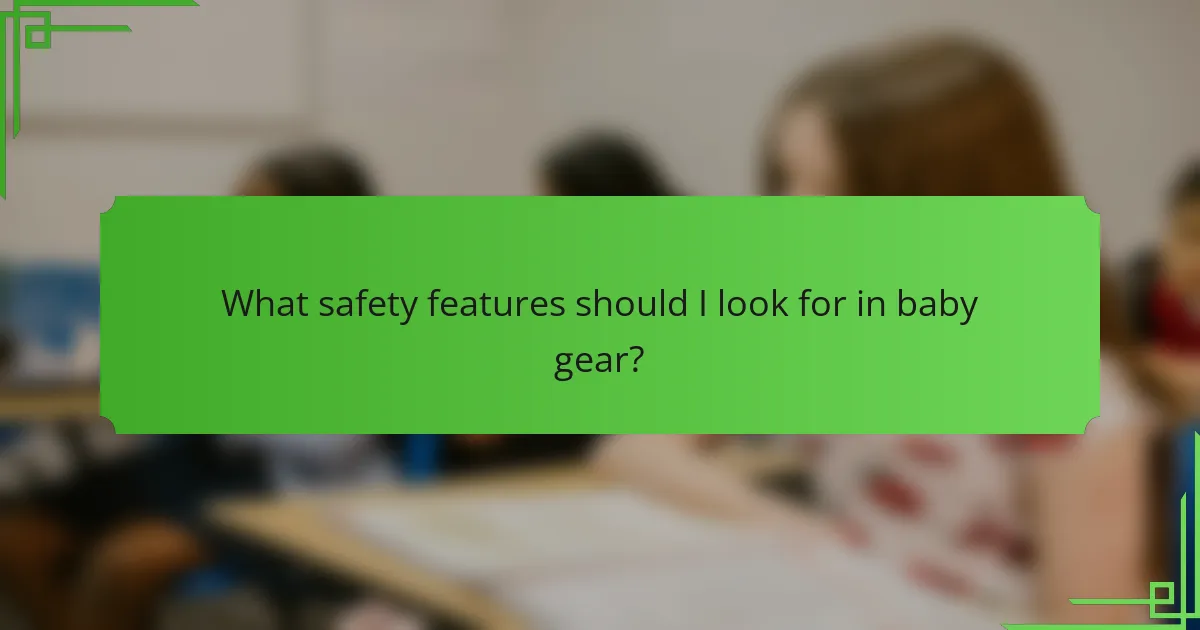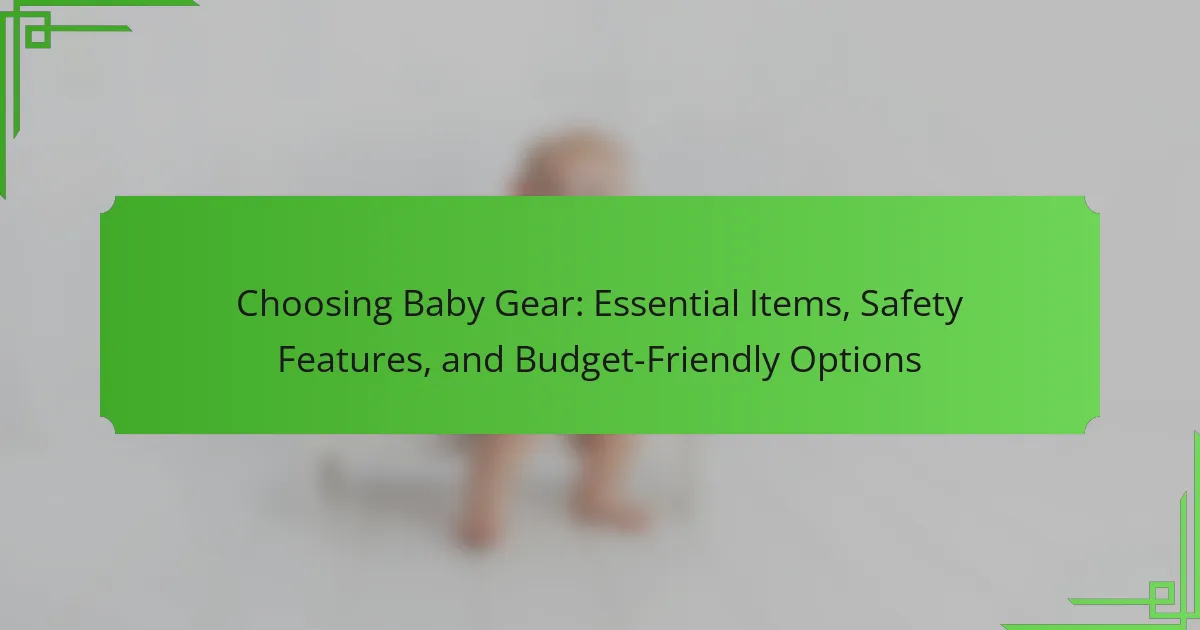Choosing baby gear involves selecting essential items that prioritize safety, comfort, functionality, and durability. Key safety features include a five-point harness, stability to prevent tipping, and non-toxic materials, all of which should comply with recognized safety standards such as ASTM and JPMA. Comfort is crucial for both the baby and caregiver, emphasizing ergonomic designs. Functionality and durability ensure ease of use and longevity of the products. Budget-friendly options include second-hand items, multi-use products, and budget brands, allowing parents to save significantly without compromising on safety or quality.

What are the essential items to consider when choosing baby gear?
When choosing baby gear, essential items include safety, comfort, functionality, and durability. Safety features are crucial; ensure products meet safety standards. Comfort is vital for both the baby and the caregiver; look for ergonomic designs. Functionality matters; choose gear that is easy to use and versatile. Durability is important; select products that withstand wear and tear. Additionally, consider portability for ease of transport. Lastly, budget is a factor; find gear that fits your financial plan while meeting quality standards.
How do I determine which baby gear is necessary for my lifestyle?
To determine which baby gear is necessary for your lifestyle, assess your daily routines and needs. Consider your living space, such as whether you live in a small apartment or a house. Evaluate your lifestyle, including how often you travel or go outdoors. Identify the essential items based on your activities, like strollers for walks or carriers for hiking. Research safety features to ensure the gear is suitable for your baby’s age and size. Budget is also a crucial factor; prioritize items that provide the best value for your needs. This approach helps streamline your choices to what fits your specific situation.
What are the must-have items for newborns?
Must-have items for newborns include a crib, diapers, clothing, and a car seat. A crib provides a safe sleeping environment, meeting safety standards is crucial. Diapers are essential for hygiene and comfort, with an average newborn using 10-12 daily. Clothing should be soft, breathable, and easy to put on. A car seat is required for safe transportation, as it is mandated by law in most regions. Other important items include swaddles for comfort, bottles for feeding, and a stroller for mobility. Each of these items plays a vital role in ensuring the well-being and safety of newborns.
Which items are essential for parents on the go?
Essential items for parents on the go include a reliable diaper bag, portable changing pad, and travel-friendly stroller. A diaper bag allows parents to carry all necessary supplies, such as diapers, wipes, and snacks. A portable changing pad provides a clean surface for diaper changes in various locations. A travel-friendly stroller offers convenience for navigating different terrains. Additionally, a baby carrier can help keep hands free while carrying the child. A compact first aid kit ensures quick access to medical supplies when needed. These items enhance mobility and preparedness for parents managing daily activities with children.
What factors should influence my choice of baby gear?
The choice of baby gear should be influenced by safety, functionality, comfort, and budget. Safety features are crucial; items should meet safety standards set by organizations like the Consumer Product Safety Commission. Functionality includes ease of use and adaptability, ensuring the gear fits your lifestyle. Comfort for the baby is essential; materials should be soft and non-toxic. Budget considerations are important; high-quality gear can be found at various price points. Research indicates that parents prioritize safety and comfort when selecting baby gear, highlighting these factors as vital in decision-making.
How does my baby’s age affect the type of gear I need?
A baby’s age significantly influences the type of gear needed. Newborns require items like cribs, bassinets, and swaddles for safe sleep. As babies grow, they transition to gear such as playpens and activity mats for developmental support. Infants around six months need high chairs and baby-proofing gear as they begin solid foods and exploring their environment. Toddlers, aged one to three, require safety gates, booster seats, and more durable toys. Each stage of growth demands specific gear tailored to safety, comfort, and developmental needs. The American Academy of Pediatrics recommends age-appropriate gear to ensure safety and support healthy development.
What role does my living space play in selecting baby gear?
Your living space significantly influences your selection of baby gear. The size and layout of your home determine the types of gear that will fit comfortably. For example, smaller living spaces may require compact or multi-functional items. Safety is another critical factor; gear must fit securely within your environment. Accessibility also matters; items should be easy to reach and use in your space. Additionally, your living space affects storage options for baby gear. Limited storage may necessitate choosing collapsible or easily storable items. Ultimately, understanding your living space helps ensure that you select appropriate, safe, and functional baby gear.

What safety features should I look for in baby gear?
Look for safety features such as a five-point harness, stability, and non-toxic materials in baby gear. A five-point harness secures the baby safely in strollers and car seats. Stability prevents tipping, particularly in high chairs and playpens. Non-toxic materials ensure no harmful chemicals are present. Additionally, check for certifications like ASTM and JPMA. These indicate compliance with safety standards. Research shows that gear meeting these standards significantly reduces injury risk. Always prioritize gear with safety features to protect your child effectively.
How can I ensure the safety of baby gear products?
To ensure the safety of baby gear products, always check for safety certifications. Look for labels from organizations such as ASTM International or the Consumer Product Safety Commission. These certifications indicate that the product meets specific safety standards. Additionally, inspect the product for recalls. The U.S. Consumer Product Safety Commission provides up-to-date information on recalled items. Follow the manufacturer’s guidelines for assembly and usage. Proper installation and adherence to instructions are crucial for safety. Regularly examine the gear for wear and tear. Damaged items should be repaired or replaced immediately. Lastly, consider age and weight recommendations. Using products outside these guidelines can pose safety risks.
What safety certifications should baby gear have?
Baby gear should have safety certifications such as ASTM, JPMA, and CPSC. ASTM (American Society for Testing and Materials) sets safety standards for various baby products. JPMA (Juvenile Products Manufacturers Association) certifies products that meet rigorous safety testing. CPSC (Consumer Product Safety Commission) ensures that baby gear complies with federal safety regulations. These certifications indicate that the products have undergone testing for safety and reliability. Choosing gear with these certifications helps ensure the safety of infants and toddlers.
How do I check for recalls on baby gear items?
To check for recalls on baby gear items, visit the Consumer Product Safety Commission (CPSC) website. The CPSC maintains a comprehensive database of recalled products. You can search by the product name or type. Additionally, check the manufacturer’s website for recall information. Many manufacturers provide updates on their products. You can also sign up for email alerts from the CPSC for real-time notifications. This ensures you stay informed about any recalls affecting your baby gear.
Why are safety features critical in baby gear selection?
Safety features are critical in baby gear selection to protect infants from potential hazards. Babies are vulnerable and require equipment that minimizes risks. Safety features include harnesses, stability, and non-toxic materials. For example, car seats must adhere to strict safety standards to prevent injury during accidents. Additionally, cribs should meet safety regulations to avoid suffocation or falls. Statistics show that proper safety measures can significantly reduce the risk of accidents. According to the American Academy of Pediatrics, using appropriate baby gear can decrease injury rates by over 50%. Therefore, prioritizing safety features is essential for ensuring a child’s well-being.
What are common safety risks associated with baby gear?
Common safety risks associated with baby gear include choking hazards, falls, and suffocation. Choking hazards can arise from small parts or loose items on gear. Falls can occur due to unstable structures like strollers or high chairs. Suffocation risks are present with items like crib bumpers or soft bedding. According to the Consumer Product Safety Commission, thousands of injuries related to baby gear occur annually. Additionally, improper installation of car seats can lead to severe injuries in accidents. Regularly checking for recalls and adhering to safety guidelines can mitigate these risks.
How do safety features vary by type of baby gear?
Safety features vary significantly across different types of baby gear. For strollers, features may include five-point harness systems and brakes to prevent rolling. Car seats often have side-impact protection and energy-absorbing foam for collision safety. Cribs usually incorporate slats spaced to prevent entrapment and adjustable mattress heights for ease of access. High chairs may feature safety straps and a stable base to prevent tipping. Each type of baby gear has unique safety attributes tailored to its specific use case. For example, the American Academy of Pediatrics recommends that car seats meet safety standards set by the National Highway Traffic Safety Administration.

What are budget-friendly options for baby gear?
Budget-friendly options for baby gear include second-hand items, essential multi-use products, and budget brands. Second-hand stores and online marketplaces often have gently used strollers, cribs, and clothing at reduced prices. Multi-use products, like convertible cribs and diaper bags that double as backpacks, save money by serving multiple purposes. Budget brands, such as Graco and Evenflo, offer quality gear at lower price points compared to premium brands. Many retailers also provide sales and discounts, making it easier to find affordable options. Research indicates that parents can save up to 50% by choosing second-hand or budget-friendly brands without sacrificing safety or quality.
How can I find affordable baby gear without compromising safety?
To find affordable baby gear without compromising safety, prioritize products that meet safety standards. Look for items certified by organizations like the Consumer Product Safety Commission (CPSC). Research brands known for balancing cost and safety features. Utilize online reviews and consumer reports to assess the safety records of specific products. Consider purchasing second-hand gear that complies with current safety regulations. Always check for recalls on used items before buying. Take advantage of sales, discounts, and clearance events to secure safe options at lower prices.
What are the best brands for budget-friendly baby gear?
The best brands for budget-friendly baby gear include Graco, Chicco, and Evenflo. Graco offers a wide range of affordable strollers and car seats. Chicco is known for its quality and safety features at reasonable prices. Evenflo provides various baby products that are budget-conscious without sacrificing safety. According to consumer reviews, these brands consistently receive high ratings for affordability and functionality. They balance cost with essential features, making them popular among parents seeking budget-friendly options.
How do I evaluate second-hand baby gear options?
To evaluate second-hand baby gear options, inspect the items thoroughly for safety and functionality. Check for recalls on the specific product model through the Consumer Product Safety Commission (CPSC) website. Look for wear and tear, such as frayed straps or cracks in plastic. Ensure that all parts are included and functioning properly. Verify that the gear meets current safety standards, which may differ from older models. Research the brand’s reputation for quality and safety. Consider the price in relation to the item’s condition and original retail value. Finally, ask the seller about the item’s history and usage to gauge its reliability.
What tips can help me save money on baby gear purchases?
Buy second-hand baby gear to save significantly. Many parents sell gently used items at a fraction of the retail price. Check local classifieds, online marketplaces, and thrift stores for deals. Join parenting groups where members sell or trade items. Look for sales during major holidays or seasonal clearance events. Utilize coupons and cashback offers available through various retailers. Consider renting larger items like cribs or strollers for short-term use. Research product reviews to ensure quality before purchase. These strategies can help you make informed, budget-friendly decisions.
How can I take advantage of sales and discounts for baby gear?
To take advantage of sales and discounts for baby gear, start by subscribing to newsletters from major retailers. Retailers often send exclusive coupons and alerts about upcoming sales to subscribers. Next, follow social media accounts of baby gear brands and stores. They frequently announce flash sales and promotional events on these platforms. Additionally, utilize price comparison websites to track price changes and identify the best deals.
Shopping during major sales events, such as Black Friday or end-of-season clearance, can yield significant savings. Many retailers offer discounts of 20% to 50% during these times. Lastly, consider joining loyalty programs. These programs often provide members with additional discounts and rewards for future purchases.
What are some essential items I can DIY or borrow instead of buying?
You can DIY or borrow several essential baby items instead of buying them. Items like baby blankets, burp cloths, and toys can easily be made at home. You can use old clothes or fabric scraps to create these items. Borrowing items such as cribs, strollers, and baby carriers from friends or family is also a great option. Many parents have items they no longer use. This approach saves money and reduces waste. Statistics show that borrowing can cut costs significantly, allowing families to allocate funds to other necessities.
Choosing baby gear is critical for ensuring safety, comfort, functionality, and durability for both infants and caregivers. This article covers essential items necessary for newborns and parents on the go, factors influencing gear selection based on lifestyle and living space, and the importance of safety features and certifications. It also explores budget-friendly options, including second-hand items and reliable brands, while providing tips for evaluating products and taking advantage of sales. Understanding these elements helps parents make informed decisions when selecting appropriate baby gear.
